Key takeaways:
- Successful composting requires a balance of “greens” (nitrogen-rich) and “browns” (carbon-rich) materials to promote decomposition.
- Regularly turning the compost pile aerates it, speeds up decomposition, and helps avoid unpleasant odors.
- Temperature monitoring and adding diverse materials enhance composting efficiency and nutrient content.
- Common mistakes include overloading the compost with acidity-heavy materials and neglecting proper aeration.
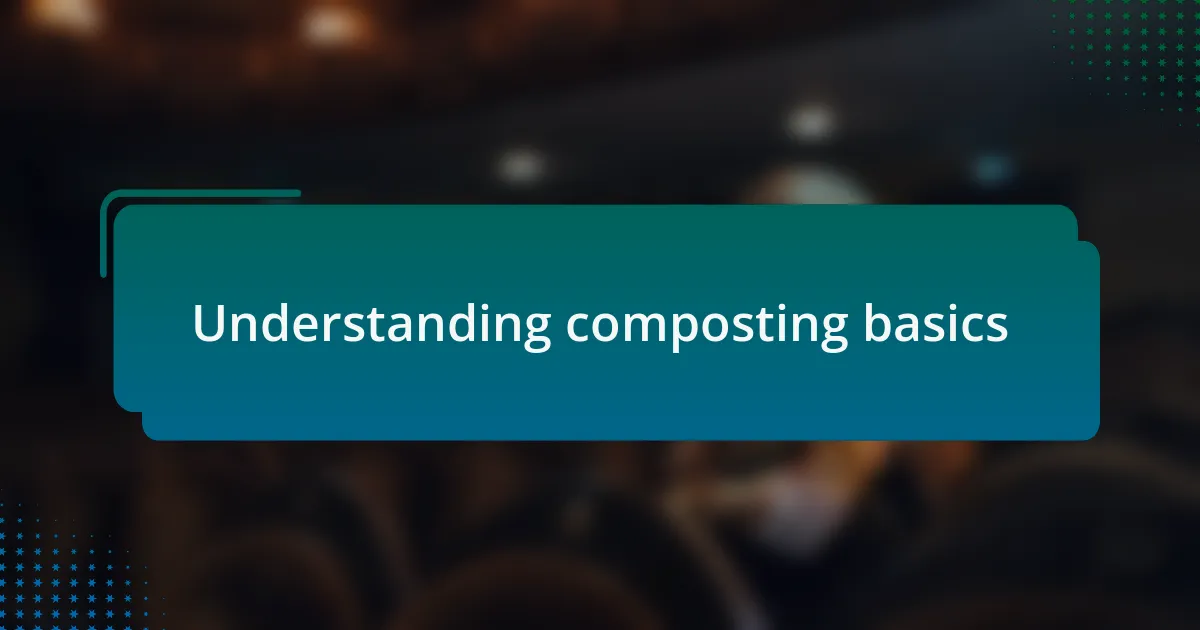
Understanding composting basics
Composting is essentially nature’s way of recycling organic waste. I remember the first time I set up my compost bin; the sight of food scraps transforming into rich, dark soil was incredibly rewarding. Have you ever held freshly composted soil in your hands? The warmth and texture are a testament to the life cycles happening beneath the surface.
To get started, it’s crucial to know that a successful compost pile needs a balance of “greens” (nitrogen-rich materials like fruit scraps) and “browns” (carbon-rich materials like dry leaves). At first, I was overwhelmed by the idea of balancing these elements, but I quickly learned that it doesn’t have to be perfect. Isn’t composting just like life, where the right mix makes all the difference?
One of the best pieces of advice I received was to turn the compost regularly. This aeration promotes decomposition and prevents bad odors, which I learned the hard way. There’s something cathartic about getting your hands dirty, and I find that the moment I flip that pile, I’m not just helping the environment, but I’m also connecting with the earth in a meaningful way.
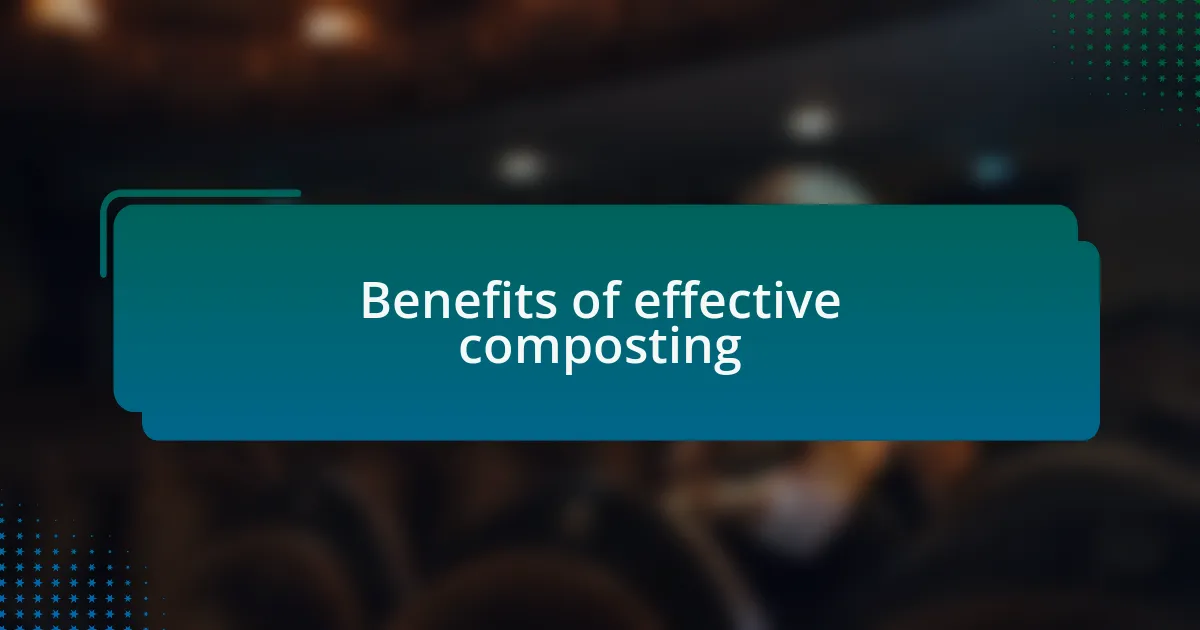
Benefits of effective composting
The benefits of effective composting are truly remarkable. For instance, I’ve seen firsthand how composting reduces landfill waste. The first time I learned about the staggering amount of food scraps that end up in those sites, I felt motivated to take action. Did you know that about 30% of what goes to landfills is organic waste? Instead of contributing to that problem, composting allows me to give back to the earth.
Additionally, composting enriches the soil, enhancing its structure and nutrient content. When I began incorporating my compost into my garden, I noticed a significant difference in plant health and growth. The vegetables I harvested tasted sweeter and more vibrant. Isn’t it amazing how a simple act of composting can transform not just waste, but the quality of our food, too?
Moreover, composting fosters biodiversity by attracting beneficial organisms like earthworms and microorganisms. I remember being amazed when I discovered a thriving ecosystem in my compost bin. Seeing those earthworms wriggling through the rich compost made me appreciate the harmony of nature even more. What if every household committed to composting? Imagine the positive impact we could have on our environment.
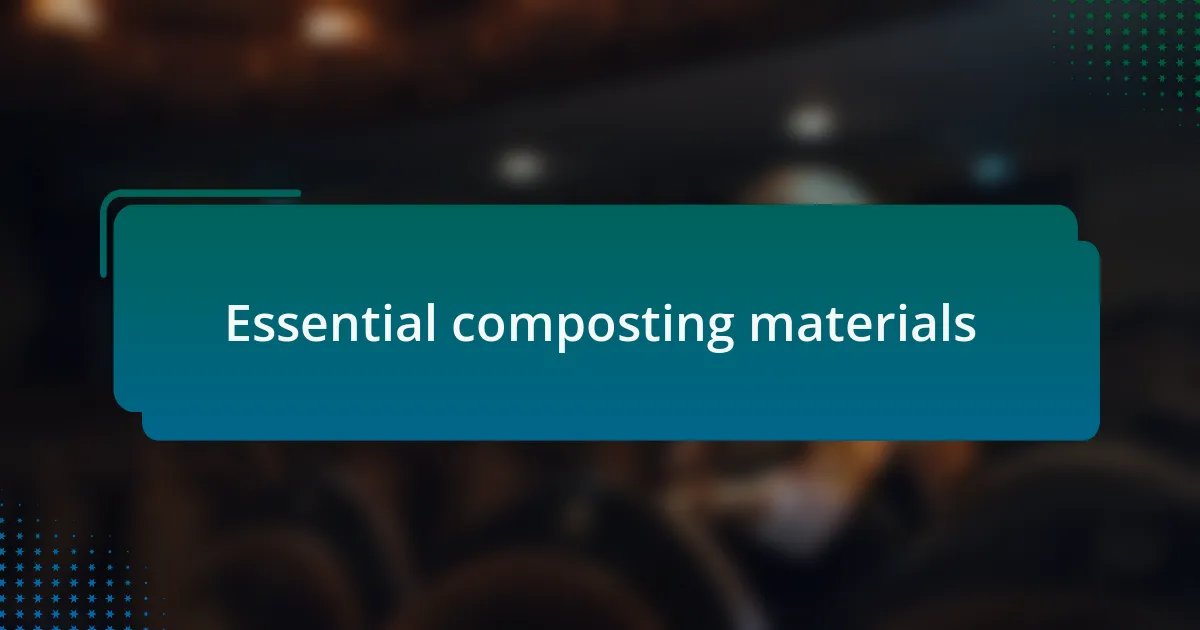
Essential composting materials
When it comes to effective composting, choosing the right materials is crucial. My compost bin thrives on a balanced mix of greens and browns. I’ve found that adding kitchen scraps, like fruit and vegetable peels, paired with dry leaves or cardboard yields the best results. The vibrant smell of decomposing organic matter is like a sign that everything is working together, creating something amazing from what we usually toss out.
I’ll never forget the moment I realized that coffee grounds are perfect nutrient boosters for compost. During a busy week, I collected endless coffee grounds from my morning brews, and once I added them to my compost pile, it felt like a secret weapon. Have you ever seen the excitement of your compost heating up? It’s like a mini transformation happening right in your backyard!
Another essential material is a good source of moisture. I’ve learned that dry ingredients need a splash of water to break down effectively. I often find myself drizzling some leftover vegetable broth into my compost when it seems too dry. This simple tweak not only revives my compost but helps me feel like I’m being a responsible steward of my waste. Isn’t it incredible how these small changes can lead to rich, dark compost that nourishes my garden?
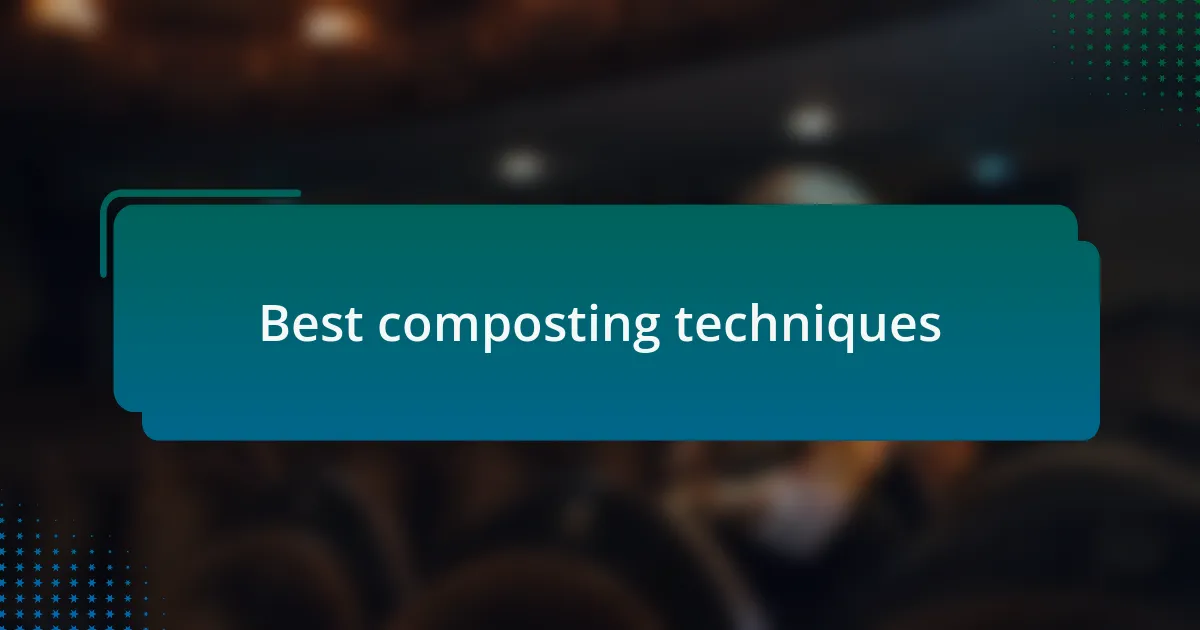
Best composting techniques
Adjusting the way I aerate my compost has been a game-changer. I’ve discovered that turning my pile regularly not only speeds up decomposition but also keeps odors at bay. There’s something satisfying about that distinct sound of the forks crunching through fresh material, don’t you think? It’s almost therapeutic, as if I’m nurturing a living entity.
Another technique I’ve implemented is layering my materials thoughtfully. I make sure to alternate between wet and dry components, which creates a natural balance. One time, I forgot to layer properly and ended up with a smelly, anaerobic mess that took weeks to fix. That experience taught me the importance of patience and organization in composting—it’s like crafting a recipe where every ingredient plays a role.
I also use worms to enhance my composting efforts. The moment I introduced red wigglers into my bin, I witnessed a fermentation process that was nothing short of magical. Watching those little creatures thrive and break down the scraps was an eye-opener for me. Have you ever thought about how nature has its own cleanup crew? Knowing that I’m harnessing that power makes me feel connected to a larger cycle of life.
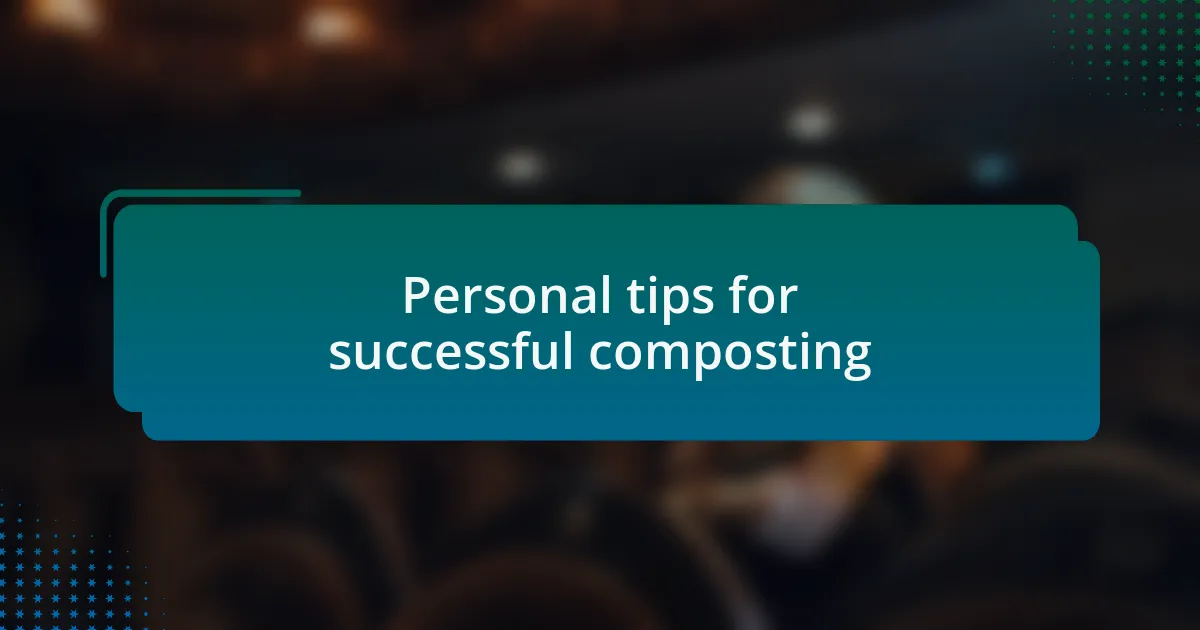
Personal tips for successful composting
One tip that has transformed my composting experience is the importance of temperature monitoring. I often use a simple kitchen thermometer to check the heat levels of my compost pile. I remember one time when I was surprised to find the center of my pile reached over 150 degrees Fahrenheit. That warmth indicated the microbes were hard at work. Isn’t it fascinating how these tiny organisms can drive such significant change?
In my journey, I’ve also learned the value of adding diverse brown materials, like shredded paper or dried leaves. One fall, as I raked leaves, I decided to throw them into the compost bin instead of bagging them. What a revelation! The rich texture and carbon content they added created an optimal environment for decomposition. Each time I see that rich, dark compost forming, I can’t help but feel a rush of pride—my little ecosystem thriving!
Lastly, I find it incredibly helpful to keep an accessible compost journal. Jotting down notes about what I added, how it smelled, or even how quickly things decomposed has been enlightening. I still chuckle when I recall the first time I recklessly tossed in pizza boxes, thinking they would break down. Spoiler alert: they didn’t. Reflecting on those mistakes not only makes me a better composter but also makes the journey feel more personal and rewarding. Don’t you think journaling could deepen your connection to the composting process?
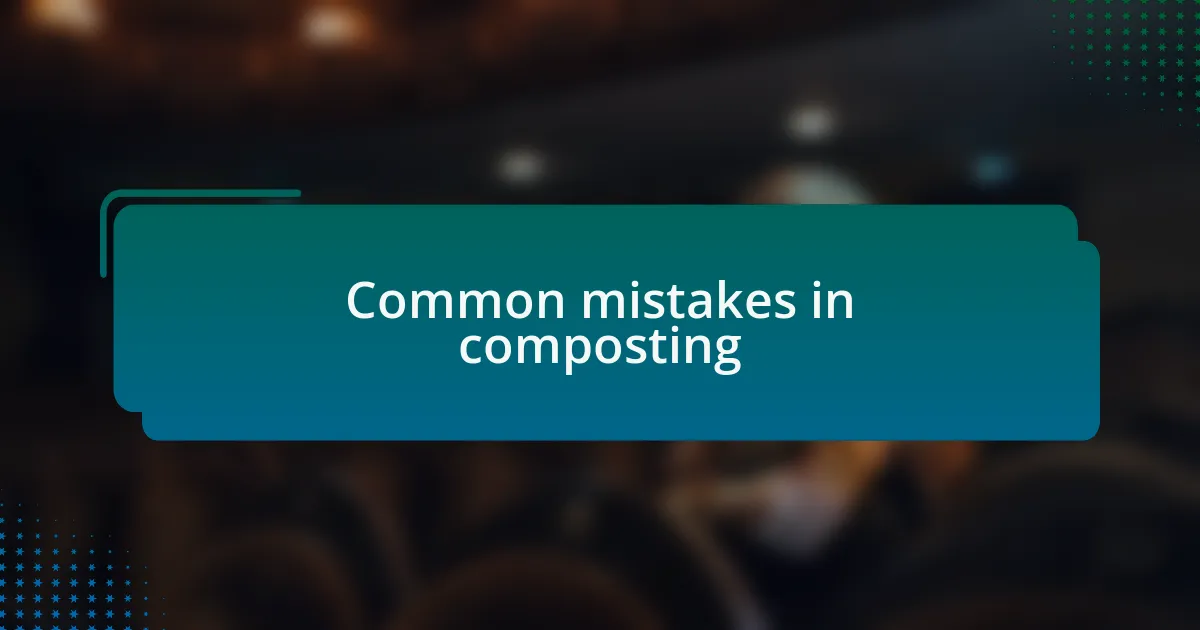
Common mistakes in composting
It’s easy to get carried away and assume all materials are compostable, but I’ve learned the hard way that not everything belongs in the bin. I once tossed in a bunch of citrus peels, thinking how organic they were. A few weeks later, I discovered that they can actually hinder decomposition due to their acidity. It’s funny how I thought I was doing a good thing, only to realize I was creating a mini disaster instead.
Another common mistake I’ve seen—and even made—is neglecting the balance between brown and green materials. I remember a time when my compost pile leaned heavily toward greens. The excess nitrogen led to a stinky mess that I couldn’t stand. It was a reminder that achieving the right ratio is key; it’s like trying to find harmony in a song. Too much of one note, and the result is discordant.
Lastly, I can’t stress enough the importance of aeration. There was a period when I simply let my pile sit without turning it. When I finally did take the effort to mix things up, I was amazed at how quickly the materials transformed. Isn’t it interesting how that little bit of effort can make a world of difference? It’s almost like giving your compost a breath of fresh air—a necessity for a thriving, healthy ecosystem!
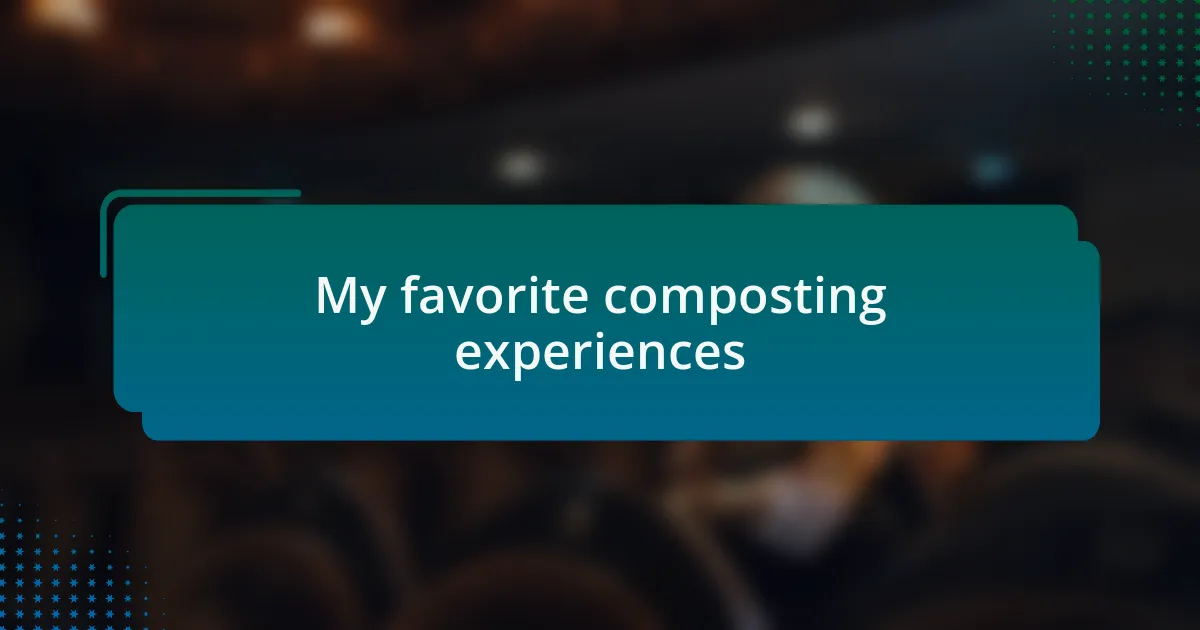
My favorite composting experiences
One of my most memorable composting experiences happened during a music festival where I volunteered as a waste diversion helper. I recall the excitement of setting up compost bins alongside recycling and trash. Seeing festival-goers consciously choose the right bin made my heart swell with pride. It was fascinating to witness the community come together, transforming our waste into something valuable while enjoying incredible music.
Another highlight has to be the time I experimented with composting shredded paper and cardboard from festival flyers. At first, I was skeptical—would it really decompose? To my surprise, after a few weeks of mixing it well with food scraps, I ended up with a nutrient-rich compost that nourished my garden. I learned that sometimes taking a chance can lead to delightful outcomes, much like discovering a new favorite band at a festival.
Then there was that unforgettable moment when I brought my kids along for a composting demo at another festival. Their eyes lit up as they learned why composting matters. Helping them understand the cycle of waste to nutrient brought a sense of joy that was almost palpable. Seeing their curiosity sparked me to think about how important education around composting is for future generations, making me want to be a part of that change.